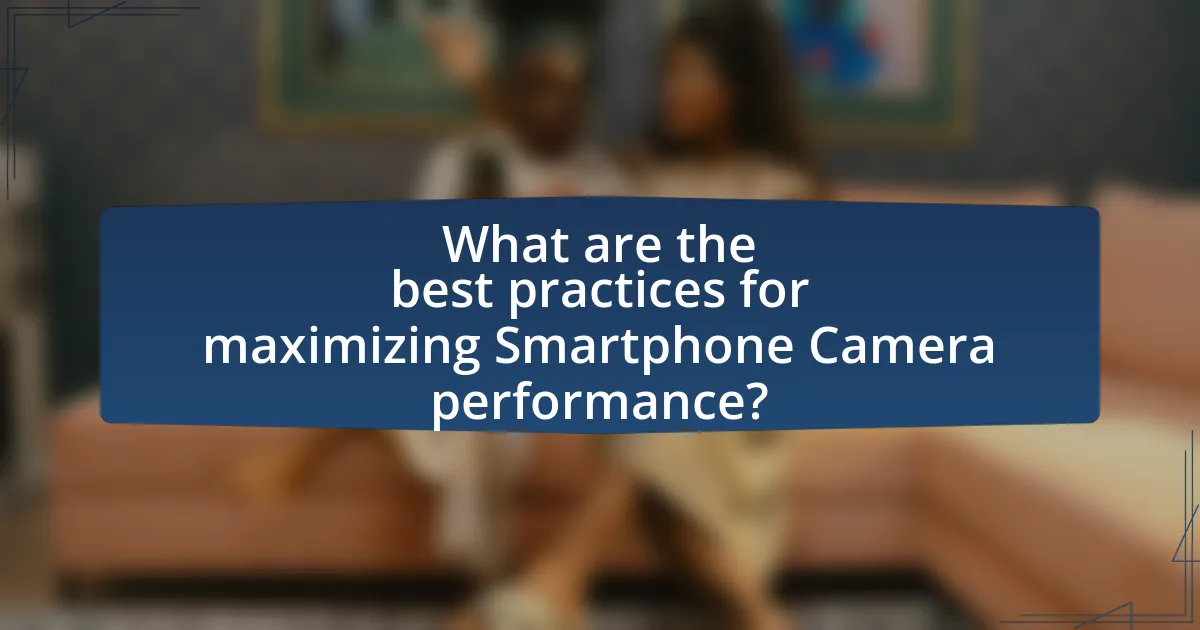Smartphone cameras are integrated imaging devices that have transformed photography by enabling users to easily capture and share images. This article explores the critical aspects of smartphone cameras, focusing on the interplay between megapixels and sensor quality. It examines how smartphone cameras differ from traditional cameras, the key components that influence their performance, and the significance of sensor quality in achieving optimal image results. Additionally, it addresses common misconceptions about megapixels, offers troubleshooting tips for common camera issues, and provides best practices for maximizing smartphone camera performance.

What are Smartphone Cameras and Why are They Important?
Smartphone cameras are integrated imaging devices within mobile phones that capture photographs and videos using digital sensors. They are important because they democratize photography, allowing users to easily document and share experiences, which has led to a significant increase in visual content creation. According to a report by Statista, as of 2021, over 1.4 trillion photos were taken globally, with a substantial portion captured using smartphone cameras, highlighting their prevalence and impact on modern communication and social media.
How do Smartphone Cameras differ from Traditional Cameras?
Smartphone cameras differ from traditional cameras primarily in their size, functionality, and technology. Traditional cameras typically feature larger sensors that capture more light, resulting in better image quality, especially in low-light conditions. In contrast, smartphone cameras utilize smaller sensors and rely on computational photography techniques to enhance image quality, often incorporating features like HDR and portrait modes. Additionally, traditional cameras offer interchangeable lenses and manual controls, allowing for greater creative flexibility, while smartphone cameras prioritize convenience and ease of use with fixed lenses and automated settings. This distinction is supported by the fact that professional photographers often prefer traditional cameras for their superior image quality and versatility, as evidenced by the widespread use of DSLRs and mirrorless systems in professional settings.
What are the key components of a smartphone camera?
The key components of a smartphone camera include the lens, image sensor, aperture, image signal processor (ISP), and software. The lens focuses light onto the image sensor, which captures the image. The aperture controls the amount of light entering the camera, affecting exposure and depth of field. The image signal processor enhances image quality by processing data from the sensor. Finally, software, including camera apps and algorithms, optimizes image capture and editing. These components work together to determine the overall performance and quality of smartphone photography.
How does the design of smartphone cameras impact their functionality?
The design of smartphone cameras significantly impacts their functionality by influencing image quality, low-light performance, and user experience. For instance, the arrangement of lenses, sensor size, and aperture design directly affect how much light is captured and how images are processed. Larger sensors typically yield better image quality and low-light performance, as evidenced by the fact that smartphones with larger sensors, like the Google Pixel series, consistently outperform those with smaller sensors in low-light conditions. Additionally, the integration of optical image stabilization (OIS) in the camera design enhances the clarity of images by reducing blurriness caused by hand movement, which is crucial for capturing sharp photos in various environments. Thus, the design elements of smartphone cameras are critical in determining their overall effectiveness and user satisfaction.
What role do Megapixels play in Smartphone Cameras?
Megapixels in smartphone cameras primarily determine the resolution of the images captured, with higher megapixel counts allowing for more detailed photos. For instance, a 12-megapixel camera can produce images with a resolution of 4032 x 3024 pixels, enabling larger prints and more cropping flexibility without significant loss of quality. However, while megapixels are important, they are not the sole factor in image quality; sensor size and technology also play critical roles in low-light performance and dynamic range. Studies have shown that a balance between megapixel count and sensor quality is essential for optimal photographic results, as evidenced by the performance of smartphones with lower megapixel counts but superior sensors, which can outperform higher megapixel devices in various conditions.
How are Megapixels defined and measured?
Megapixels are defined as one million pixels, representing the resolution of an image captured by a camera sensor. They are measured by multiplying the width and height of the image in pixels; for example, an image with a resolution of 4000 x 3000 pixels has a total of 12 million pixels, or 12 megapixels. This measurement indicates the potential detail and clarity of the image, with higher megapixel counts generally allowing for larger prints and more detailed cropping.
What is the relationship between Megapixels and image resolution?
Megapixels directly influence image resolution, as they represent the total number of pixels in an image. Specifically, one megapixel equals one million pixels, and higher megapixel counts generally lead to greater image detail and clarity. For instance, a camera with 12 megapixels can produce images with a resolution of approximately 4000 x 3000 pixels, allowing for larger prints and more detailed cropping without loss of quality. However, it is essential to note that while more megapixels can enhance resolution, the overall image quality also depends on other factors such as sensor size, lens quality, and image processing capabilities.
Why is Sensor Quality crucial in Smartphone Cameras?
Sensor quality is crucial in smartphone cameras because it directly impacts image clarity, low-light performance, and overall photographic detail. High-quality sensors capture more light and detail, resulting in sharper images with better color accuracy. For instance, larger sensors, such as those found in premium smartphones, can significantly improve performance in dim lighting conditions, reducing noise and enhancing dynamic range. Studies have shown that smartphones with advanced sensor technology, like those utilizing larger pixel sizes or specialized materials, produce images that are often comparable to those taken with dedicated cameras, underscoring the importance of sensor quality in achieving superior photographic results.
What factors contribute to sensor quality?
Sensor quality is primarily influenced by factors such as sensor size, pixel size, dynamic range, and image processing capabilities. Larger sensors typically capture more light, resulting in better image quality, especially in low-light conditions. Additionally, larger pixels can gather more light, enhancing the sensor’s sensitivity and reducing noise. Dynamic range refers to the sensor’s ability to capture details in both bright and dark areas of an image, which is crucial for overall image fidelity. Finally, advanced image processing algorithms can significantly improve the final output by optimizing color accuracy and reducing artifacts, thereby enhancing the perceived quality of images produced by the sensor.
How does sensor size affect image quality?
Sensor size significantly affects image quality by influencing the amount of light captured and the level of detail in an image. Larger sensors can gather more light, which enhances performance in low-light conditions and reduces noise, resulting in clearer images with better dynamic range. For instance, a full-frame sensor typically produces superior image quality compared to a smaller sensor, such as a micro four-thirds sensor, due to its ability to capture more light and detail. This is supported by studies showing that larger sensors yield images with less grain and better color accuracy, particularly in challenging lighting situations.
![]()
How do Megapixels and Sensor Quality interact in Smartphone Cameras?
Megapixels and sensor quality interact in smartphone cameras by determining the overall image resolution and clarity. Higher megapixel counts can produce more detailed images, but if the sensor quality is poor, the images may suffer from noise, low light performance issues, and inadequate dynamic range. For instance, a smartphone with a 48-megapixel sensor may not perform as well as a 12-megapixel camera with a larger, higher-quality sensor, as the latter can capture more light and detail in various conditions. This relationship highlights that while megapixels contribute to resolution, sensor quality is crucial for achieving optimal image performance, especially in challenging lighting situations.
What are the common misconceptions about Megapixels?
Common misconceptions about megapixels include the belief that higher megapixel counts always result in better image quality and that megapixels are the sole determinant of a camera’s performance. In reality, image quality is significantly influenced by sensor size, lens quality, and image processing capabilities. For instance, a smartphone camera with 12 megapixels can produce superior images compared to one with 48 megapixels if the former has a larger sensor and better optics. This is supported by studies showing that sensor quality often outweighs megapixel count in determining overall image fidelity.
Why do higher Megapixels not always mean better photos?
Higher megapixels do not always mean better photos because image quality is influenced more by sensor size, lens quality, and processing algorithms than by pixel count alone. For instance, a smartphone with a 12-megapixel sensor can produce superior images compared to a 48-megapixel sensor if the former has a larger sensor that captures more light and detail. Research indicates that larger sensors, such as those found in professional cameras, can significantly enhance low-light performance and dynamic range, leading to clearer and more vibrant images. Additionally, higher megapixel counts can result in increased noise and reduced image quality if the sensor is not capable of handling the additional data effectively.
How does sensor quality mitigate the limitations of Megapixels?
Sensor quality mitigates the limitations of megapixels by enhancing image clarity, dynamic range, and low-light performance. High-quality sensors can capture more light and detail, resulting in better image quality even at lower megapixel counts. For instance, a smartphone with a 12-megapixel sensor of superior quality can produce images that rival those from a 20-megapixel sensor with inferior quality, as evidenced by tests showing that larger individual pixels in high-quality sensors can gather more light, reducing noise and improving overall image fidelity.
How can users evaluate the performance of Smartphone Cameras?
Users can evaluate the performance of smartphone cameras by analyzing key factors such as image quality, low-light performance, autofocus speed, and video capabilities. Image quality can be assessed through resolution, color accuracy, and dynamic range, with higher megapixels often indicating better detail but not necessarily superior quality due to sensor size and technology. Low-light performance is crucial, as it determines how well a camera captures images in dim conditions; this can be evaluated through sample images taken in low-light scenarios. Autofocus speed affects how quickly a camera can lock onto a subject, which is essential for capturing fast-moving objects. Video capabilities, including resolution and frame rates, also play a significant role in overall camera performance. Users can refer to expert reviews and comparison tests from reputable sources like DxOMark, which provides detailed assessments and scores based on standardized testing methods.
What specifications should users look for when comparing cameras?
Users should look for specifications such as megapixel count, sensor size, aperture, ISO range, and image stabilization when comparing cameras. Megapixel count indicates the resolution of images, with higher counts allowing for larger prints and more detail. Sensor size affects image quality, particularly in low light; larger sensors typically capture more light and detail. Aperture size influences depth of field and low-light performance, with wider apertures allowing more light. ISO range determines the camera’s sensitivity to light, impacting performance in various lighting conditions. Image stabilization helps reduce blurriness from camera shake, enhancing image clarity. These specifications collectively influence the overall performance and quality of the camera.
How do real-world tests compare to specifications in assessing camera quality?
Real-world tests provide a more accurate assessment of camera quality compared to specifications, as they evaluate performance in practical scenarios rather than theoretical limits. Specifications, such as megapixel count and aperture size, offer a baseline understanding of a camera’s capabilities, but they do not account for factors like image processing, low-light performance, and dynamic range, which are critical in everyday use. For instance, a smartphone with a lower megapixel count may outperform a higher megapixel device in low-light conditions due to superior sensor technology and image processing algorithms. Studies, such as those conducted by DxOMark, demonstrate that real-world performance metrics often reveal significant differences in image quality that specifications alone cannot predict, highlighting the importance of practical testing in evaluating camera effectiveness.

What are the best practices for maximizing Smartphone Camera performance?
To maximize smartphone camera performance, users should focus on optimizing lighting conditions, utilizing manual settings, and maintaining lens cleanliness. Proper lighting significantly enhances image quality, as cameras perform best in well-lit environments; for instance, natural light can reduce noise and improve detail. Employing manual settings allows users to adjust exposure, ISO, and focus, which can lead to more professional-looking photos. Additionally, keeping the lens clean prevents smudges and dirt from degrading image clarity, ensuring that the camera captures the best possible quality. These practices are supported by photography experts who emphasize the importance of these factors in achieving optimal results.
How can users improve their photography skills with Smartphone Cameras?
Users can improve their photography skills with smartphone cameras by mastering composition techniques, utilizing natural light, and experimenting with editing apps. Understanding composition, such as the rule of thirds, helps users frame their shots effectively, while natural light enhances image quality, as studies show that photos taken in good lighting conditions are generally clearer and more vibrant. Additionally, using editing apps allows users to refine their images, with research indicating that post-processing can significantly enhance the final output, making it more visually appealing.
What techniques can enhance image quality regardless of Megapixels?
Techniques that can enhance image quality regardless of megapixels include image stabilization, post-processing algorithms, and lens quality optimization. Image stabilization reduces blurriness caused by camera shake, improving clarity in photos. Post-processing algorithms, such as noise reduction and sharpening, enhance details and reduce artifacts, making images appear more refined. Additionally, high-quality lenses minimize optical distortions and improve light transmission, contributing to better overall image quality. These techniques are widely recognized in photography, as they can significantly impact the final output, independent of the camera’s megapixel count.
How can lighting and composition affect smartphone photography?
Lighting and composition significantly influence smartphone photography by determining image quality and visual appeal. Proper lighting enhances details, colors, and textures, while poor lighting can lead to noise and loss of detail. For instance, natural light during golden hour provides soft, warm tones that improve image aesthetics. Composition, including the rule of thirds and leading lines, guides the viewer’s eye and creates balance, making images more engaging. Studies show that well-composed images are perceived as more professional and visually appealing, which is crucial for smartphone photography where users often prioritize quick, high-quality captures.
What common issues do users face with Smartphone Cameras?
Users commonly face issues with smartphone cameras such as poor low-light performance, slow autofocus, and image noise. Poor low-light performance is often due to smaller sensor sizes compared to dedicated cameras, resulting in less light capture and lower image quality in dim conditions. Slow autofocus can occur because many smartphone cameras rely on contrast detection rather than phase detection, leading to delays in focusing on subjects. Additionally, image noise is prevalent in photos taken at higher ISO settings, which is a common necessity in low-light situations, further degrading image quality. These issues highlight the limitations of smartphone cameras in comparison to traditional cameras, particularly in challenging shooting environments.
How can users troubleshoot common camera problems?
Users can troubleshoot common camera problems by systematically checking settings, ensuring proper lighting, and inspecting the lens for obstructions. First, users should verify that the camera app is updated and that all necessary permissions are granted. Next, adjusting settings such as resolution and HDR can resolve issues related to image quality. Additionally, ensuring adequate lighting conditions can significantly improve photo clarity, as low light can lead to grainy images. Finally, users should clean the lens to remove any smudges or dirt that may affect image quality. These steps are effective because they address the most frequent causes of camera malfunctions, such as software glitches, environmental factors, and physical obstructions.
What maintenance tips can help prolong the life of a smartphone camera?
To prolong the life of a smartphone camera, regularly clean the lens with a microfiber cloth to prevent scratches and smudges that can affect image quality. Additionally, avoid exposing the camera to extreme temperatures and moisture, as these conditions can damage internal components. Storing the smartphone in a protective case can also shield the camera from physical impacts. According to a study by the Consumer Electronics Association, proper maintenance can extend the lifespan of electronic devices, including smartphone cameras, by up to 30%.




